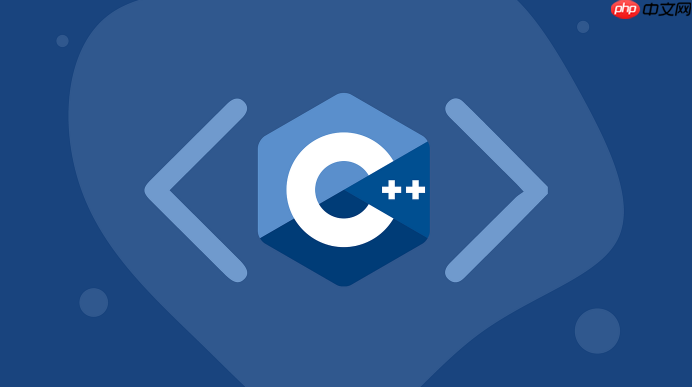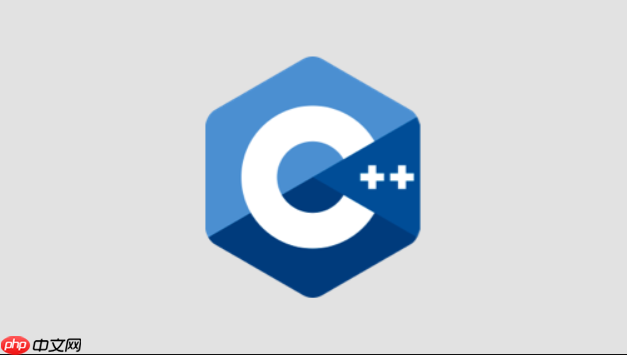原型模式通过复制现有对象创建新对象,其核心在于实现clone()方法以支持深拷贝。1. 深拷贝确保克隆对象与原始对象完全独立,避免多个对象共享同一内存导致的修改副作用;2. 对于复杂数据结构如嵌套对象或容器,需递归克隆每个元素以实现完整复制;3. 为避免对象切片问题,clone()方法应使用协变返回类型,使派生类的克隆返回正确类型,保持对象特性完整。

原型模式是一种创建型设计模式,它允许你通过复制现有对象来创建新对象,而无需知道创建对象的具体类。深拷贝在原型模式中至关重要,确保克隆对象与原始对象完全独立。

解决方案
原型模式的核心在于
Clone()
立即学习“C++免费学习笔记(深入)”;

#include <iostream>
#include <string>
class Prototype {
public:
virtual Prototype* Clone() = 0;
virtual void Display() = 0;
virtual ~Prototype() {} // 确保基类析构函数是虚函数
};
class ConcretePrototype : public Prototype {
public:
ConcretePrototype(std::string name, int* value) : name_(name), value_(value) {}
ConcretePrototype* Clone() override {
// 深拷贝:分配新的内存,复制数据
int* newValue = new int(*value_);
return new ConcretePrototype(name_, newValue);
}
void Display() override {
std::cout << "Name: " << name_ << ", Value: " << *value_ << std::endl;
}
~ConcretePrototype() {
delete value_; // 释放深拷贝分配的内存
}
private:
std::string name_;
int* value_; // 指针成员
};
int main() {
int initialValue = 10;
ConcretePrototype* original = new ConcretePrototype("Original", &initialValue);
original->Display();
ConcretePrototype* clone = original->Clone();
clone->Display();
// 修改克隆对象,验证深拷贝
int* cloneValue = clone->value_;
*cloneValue = 20;
clone->Display();
original->Display(); // 原始对象不受影响
delete original;
delete clone;
return 0;
}这个例子中,
ConcretePrototype
name_
value_
Clone()
value_
副标题1:为什么要使用深拷贝而不是浅拷贝?

浅拷贝仅仅复制对象中的值,包括指针的值。如果多个对象共享同一块内存(例如,通过指针),修改其中一个对象的数据会影响所有其他对象。深拷贝则为克隆对象分配新的内存,并将原始对象的数据完全复制到新的内存中。这样,克隆对象与原始对象完全独立,修改一个对象不会影响另一个对象。在原型模式中,深拷贝是保证对象独立性的关键。使用浅拷贝会破坏原型模式的意图,导致意外的副作用和难以调试的问题。
副标题2:如何处理包含复杂数据结构(例如,嵌套对象、容器)的对象克隆?
处理包含复杂数据结构的对象克隆需要递归地进行深拷贝。对于嵌套对象,需要克隆每个嵌套对象。对于容器(例如,
std::vector
std::list
#include <iostream>
#include <vector>
#include <string>
class NestedObject {
public:
NestedObject(std::string data) : data_(data) {}
NestedObject* Clone() {
return new NestedObject(data_); // 字符串的复制自动进行深拷贝
}
void Display() {
std::cout << "Nested Data: " << data_ << std::endl;
}
private:
std::string data_;
};
class ComplexPrototype : public Prototype {
public:
ComplexPrototype(std::string name, std::vector<NestedObject*> objects) : name_(name), objects_(objects) {}
ComplexPrototype* Clone() override {
std::vector<NestedObject*> clonedObjects;
for (NestedObject* obj : objects_) {
clonedObjects.push_back(obj->Clone()); // 递归克隆
}
return new ComplexPrototype(name_, clonedObjects);
}
void Display() override {
std::cout << "Name: " << name_ << std::endl;
for (NestedObject* obj : objects_) {
obj->Display();
}
}
~ComplexPrototype() {
for (NestedObject* obj : objects_) {
delete obj;
}
}
private:
std::string name_;
std::vector<NestedObject*> objects_;
};
int main() {
std::vector<NestedObject*> objects;
objects.push_back(new NestedObject("Data1"));
objects.push_back(new NestedObject("Data2"));
ComplexPrototype* original = new ComplexPrototype("Original", objects);
original->Display();
ComplexPrototype* clone = original->Clone();
clone->Display();
delete original;
delete clone;
return 0;
}这个例子中,
ComplexPrototype
std::vector
NestedObject
Clone()
std::vector
NestedObject
副标题3:如何避免对象切片问题?
对象切片是指将派生类对象赋值给基类对象时,派生类特有的信息丢失的现象。在原型模式中,如果
Clone()
Clone()
class Base {
public:
virtual Base* clone() {
return new Base(*this);
}
virtual void print() { std::cout << "Base\n"; }
};
class Derived : public Base {
public:
Derived* clone() override {
return new Derived(*this);
}
void print() override { std::cout << "Derived\n"; }
};
int main() {
Base* b = new Base();
Base* bClone = b->clone();
bClone->print(); // 输出 "Base"
delete b;
delete bClone;
Derived* d = new Derived();
Base* dClone = d->clone(); // 注意这里,返回的是Base*
dClone->print(); // 输出 "Base",发生了对象切片!
Derived* dCloneCorrect = d->clone();
dCloneCorrect->print(); // 输出 "Derived",正确克隆
delete d;
delete dClone;
delete dCloneCorrect;
return 0;
}为了解决对象切片问题,需要让基类的
clone
clone
以上就是C++原型模式怎么应用 深拷贝与对象克隆实现方案的详细内容,更多请关注php中文网其它相关文章!

每个人都需要一台速度更快、更稳定的 PC。随着时间的推移,垃圾文件、旧注册表数据和不必要的后台进程会占用资源并降低性能。幸运的是,许多工具可以让 Windows 保持平稳运行。

Copyright 2014-2025 https://www.php.cn/ All Rights Reserved | php.cn | 湘ICP备2023035733号